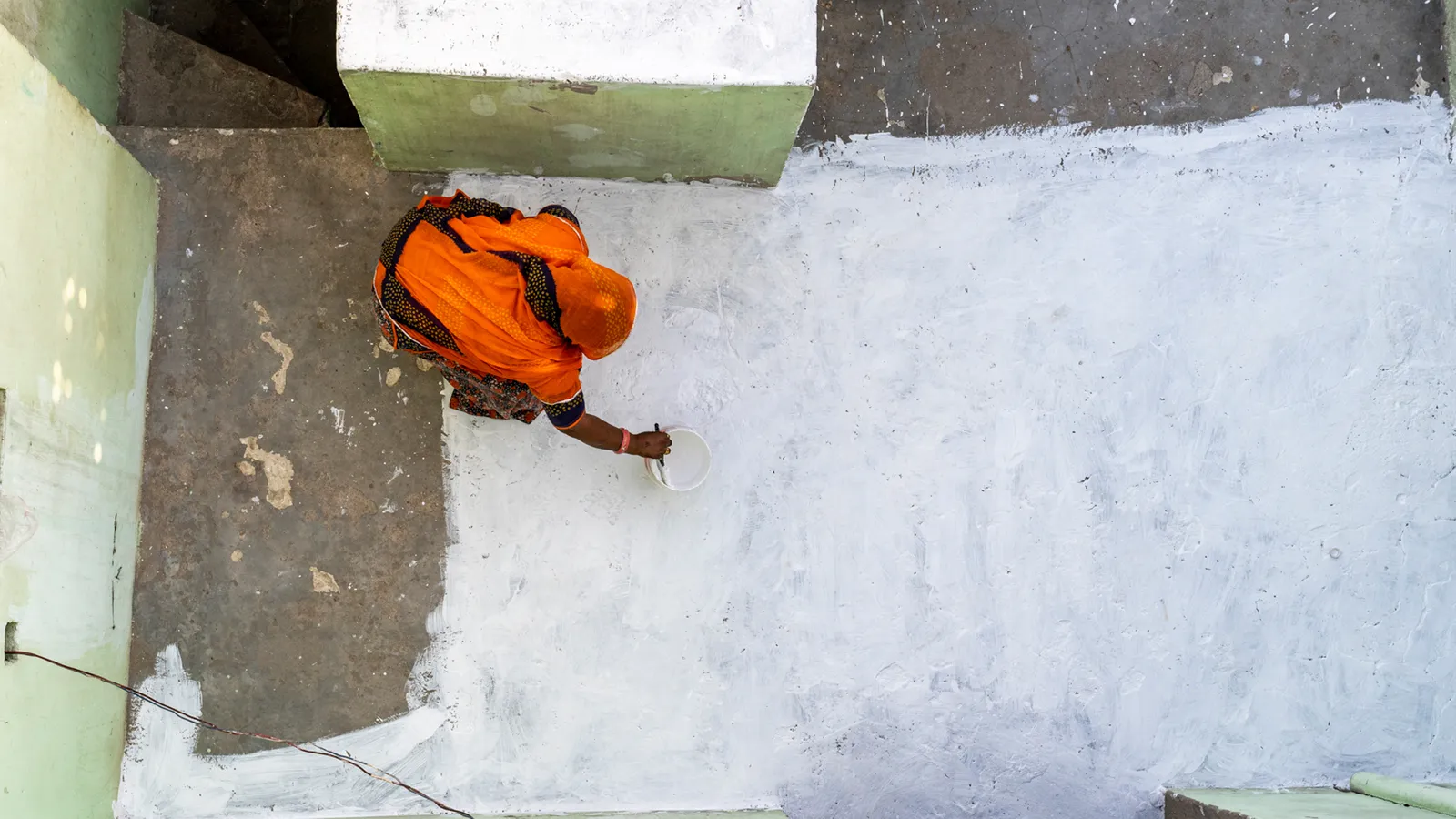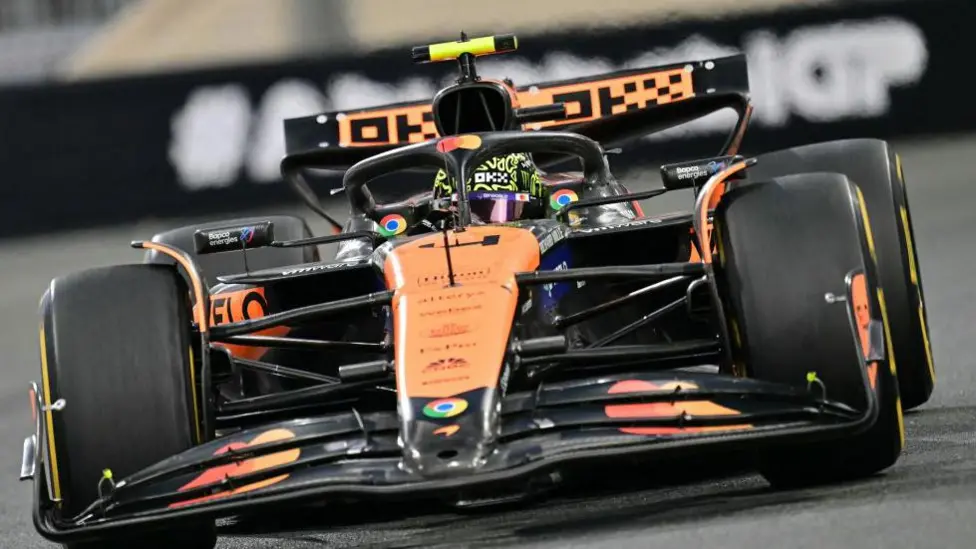The white roofs cooling women's homes in Indian slums
Extreme heat is having a detrimental impact on women living in Indian slums. Now a simple solution is helping them keep cool.

The roof in Pinky's home in western India glistens in the bright sunlight. Covered in white solar reflective paint, it helps to limit the oppressive heat – which can reach 47.8C (118F) in June – from infiltrating her home during the hottest months.
Pinky and her four siblings, who are from the Bhil tribe – one of the largest tribes in India – live in a two-room home in Badi Bhil Basti, a slum in Jodhpur, the second largest city in the state of Rajasthan. Both their parents have died.
In March, Pinky and other women from Badi Bhil Basti applied coats of white solar reflective paint to their roofs. They had learned about the paint in the community meetings led by Mahila Housing Trust (MHT), a non-profit that helps poor women in Indian cities build heat resilience.
From the top of the hill where they live, one can see brown and beige homes, many with gleaming white roofs.
"We painted the roof ourselves. It felt very good to paint one's own home," says 19-year old Pinky, who only uses her first name. She is a high school student and part-time tutor to local children. Since applying the paint, Pinky has noticed that her home feels cooler. Now Pinky and her students can sit downstairs during the afternoon and focus on studying.
This artlcle was supported by funding from the European Journalism Centre, through the Solutions Journalism Accelerator. This fund is supported by the Bill & Melinda Gates Foundation.
Badi Bhil Basti is situated in the Thar desert. The homes in the slum are tiny, makeshift structures made of heat-trapping materials such as tin, asbestos, bricks, cement, concrete and tarpaulin. A study by the Central Arid Zone Research Institute projected that average yearly temperatures in Jodhpur, the second largest city in Rajasthan to the east of the Thar desert, will increase by 2.9C by the end of the 21st Century.
Many women living in slums across India are suffering from extreme heat, which is expected to worsen as temperatures continue to rise. Last year, research by the UK's Met Office found that climate change makes heatwaves during April and May in northwest India 100 times more likely.
In 2022, India experienced its hottest March on record in 122 years. Twelve people died from heatstroke in an open air event in Mumbai. Meanwhile, an assessment carried out by a group of scientists from 10 countries found that climate change made the heatwave in India in April this year 30 times more likely. A 2021 study found that heatwaves killed 17,000 people between 1971 and 2019 in India.
The stifling heat is having a detrimental impact on women's health and productivity, decreasing their work hours and reducing their income. But by helping residents paint their roofs with white solar-reflective paint, MHT is providing an simple solution that keeps the worst of the heat from penetrating buildings and lowers indoor temperatures. It is already bringing some relief to women, children and elderly people living in the slums. They say they can now comfortably spend time indoors during the summer, which is helping to improve their health while allowing them to work and study at home.
MHT started working on sustainable cooling in Ahmedabad, in the western Indian state of Gujarat, in 2009. After learning about slum residents' high electricity bills, the non-profit piloted a range of cooling solutions, including white paint, green roofs, Airlite – a translucent plastic sheet that lets in light and improves ventilation – and ModRoof, a modular roof made from cardboard and agricultural waste.
While all solutions helped lower temperatures, the white solar reflective paint was the most accessible for women living in slums because of its comparatively low price, says Bhavna Maheriya, MHT’s programme manager. In 2017, after MHT’s work was noticed by the local authorities, the non-profit was invited to contribute to a revision of the Ahmedabad Heat Action Plan, a first of its kind policy which provides state-level guidelines to prepare for extreme heat. The updated plan recommended painting roofs white as a heat relief measure.
Before MHT started working in Badi Bhil Basti in Jodhpur, Pinky and other women in the slum tried to keep cool in the scorching summer heat by dampening the curtains in their living room and making multiple trips to their roof with a bucket to wet a burlap sack. They would spread the sack above a fan so that it would blow cooler air into the rooms below.
But these interventions didn't prevent Pinky from feeling sick. "I felt suffocated sometimes…I vomited in the evenings," she says. "It was too hot inside… Some children got nosebleeds and vomited because of the heat." Her only recourse was drinking lemonade and taking antacids in an attempt to combat her nausea.
In April, the Jodhpur Heat Action Plan was launched by the Municipal Corporation of Northern Jodhpur, MHT and the Natural Resources Defense Council (NRDC) India. The plan includes a heat vulnerability assessment made by analysing data from satellite imagery, census and local surveys before assigning a heat risk score to each neighbourhood. Badi Bhil Basti, Ravti and Meghwal Basti, where MHT has painted roofs, all have a very high score of nine out of 10. This risk comes from a combination of the high density of population and buildings, the lack of proper roads, water and vegetation in these areas.
Pinky and other women in Jodhpur and Ahmedabad say they have experienced dehydration and weakness due to extreme heat. These are just a few of the symptoms of heat-related illnesses such as heatstroke, heat exhaustion, fainting and heat rash. Women also experience pregnancy complications due to extreme heat.
Women living in slums are particularly vulnerable to heat stress, says Dharmistha Chauhan, a gender and social inclusion expert at the Asian Development Bank. During a heatwave in Ahmedabad in May 2010 which killed 1,344 people in one week when temperatures reached 46.8C (116F), 53% of fatalities were women.
In 2021, Homenet South Asia, a network of home-based worker organisations, surveyed over 200 women in slums and informal settlements India, Bangladesh and Nepal to understand how climate change impacts them. This research, led by Chauhan, found that 43% of women reported a loss of cash income, while 41% said their productivity had reduced and largely attributed it to climate change, particularly rising temperatures. Women tend to work in the afternoon, the hottest time of the day. The stifling heat therefore has a direct impact on women's capacity to work, says Chauhan.
Prakash Kanwar, 45, lives uphill from Pinky's house with her family of seven in a small three-room home. "In the hot months, I feel uneasy. My blood pressure is low and I have a burning sensation when I pass urine," she says.
Some kilometres away, in the slum of Ravti, Sanjana, 36, a folk dancer lives with her family of three in a one-room home with a tin sheet. "The heat caused my period to be long. I felt dizzy very often. I couldn't get up and work," she says. Sanjana is a member of a local community action group formed by MHT and a Dalit – the lowest in India's caste system and one of the most oppressed groups in the world.
Over 450km (280 miles) away, in Bapalal Kadiya Ni Chali in Ahmedabad, Aruna Nagin Patni sits on the floor of her two-room house which is covered with a tin sheet. She recalls how she suffered from heat stroke during her pregnancy in 2014. "I went to the gynaecologist, got medication and a glucose drip," says the 29-year old, who works as a vegetable vendor.
Kanwar, Sanjana and Patni have all now painted their roofs with white reflective paint provided by MHT. The non-profit has been working in informal settlements and slums in India for 28 years and has installed 30,000 cool roofs in nine states. In addition to supplying the paint, MHT organises training sessions for women in the slums where they are taught about climate change and given practical guidance on how to avoid heat stress. In Jodhpur, MHT also notifies the communities about hot weather through colour-coded heat alerts which are displayed on banners in the streets and sent to women's phones. (Hear more from the people trying to make super-heated cities liveable).
Future Planet's series Climate Guardians spotlights the stories of those on the frontline of the climate crisis. Using on-the-ground, local reporting, it delves into the climate solutions being pioneered by women and indigenous communities in the Global South to learn what they can teach the rest of the world. It also investigates how they can alleviate other problems such as gender inequality, food insecurity, health and poverty.
"We collectivise poor women and teach them the science of climate change," says Bijal Brahmbhatt, MHT's executive director. "[This] action starts at the household level, moves to the settlement and then reaches the city level. Women create a pressure group to implement city heat action plans and that's how actions continue to happen on the ground."
Before she was given the solar reflective paint, Pinky attended a two-day training session led by MHT. "I learned that if I get the roof painted, the temperature will reduce by 2C to 4C. It will be cooler indoors, the fan will blow cool air and when we step on the roof our feet will not burn," she says.
Initially she was sceptical and concerned about the cost. Things changed when MHT provided free paint for 116 roofs in her area. An MHT field organiser brought a digital device to measure indoor temperature in all homes. Pinky saw the readings for five continuous days before the paint was applied. "After the painting, I checked the temperature myself. It was 2C lower."
In India, many families sleep on the roof because the heat indoors is unbearable. Pinky no longer has to climb on the roof to soak the burlap sack multiple times a day. Nor does she have to throw water on the roof at night-time before her family goes there to sleep, a common practice in the slum.
"Earlier the smaller kids [whom I tutor] would constantly complain about the heat. Due to the heat, parents would not send them. Now the children don't get nosebleeds." She says more children now visit her home for tutoring, meaning she earns more.
MHT and scientists have also been studying the effectiveness of cool roofs. A 2020 study, co-authored by Brahmbhatt and Priya Dutta, from the Indian Institute of Public Health in Gandhinagar, compared roofs painted with solar reflective paint with those without. The temperature of the roofs coated with solar reflective paint was 1C lower than the uncoated tin roofs, the study found.
The study also compared four types of cool roofs with regular roofs. It found that at the hottest time of the day, ModRoof is approximately 4.5C cooler than asbestos sheet roof. There was no discernible temperature difference with concrete and tin roofs.
However, Dutta explains that she studied a very small sample size of 16 households due to lack of funds. The study also has other limitations, she adds: it does not take factors such as indoor biomass-based cooking and lack of ventilation into account, which heat homes up further.
The University of Chicago is assessing the impact of MHT's cool roofs on temperatures in a Delhi slum. Anant Sudarshan, the principal investigator and senior fellow at the Energy Policy Institute, University of Chicago, says that although temperatures only decreased by 1C after the white paint was applied, residents reported not needing to use as much water for cooling and, therefore, saving money. However, there was little impact on the amount of electricity they used.
The emissions from travel it took to report this story were 40kg CO2. The digital emissions from this story are an estimated 1.2g to 3.6g CO2 per page view. Find out more about how we calculated this figure here.
Aaron Bach, research fellow and thermophysiologist at Griffith University in Australia, recently published a study on modifying a garment factory in Bangladesh with passive cooling. The study found that four types of cool roofs, including white roofs, each reduce indoor air temperatures by around 2C. Other studies analysing the impact of white cool roofs in schools in rural India and Greece found indoor temperature reductions of 1.5-2C and 1.3-2.3C respectively.
Overall, painting roofs white is a simple solution which could be applied in many heat-stressed locations worldwide, including Nepal, Sri Lanka and Bangladesh, says Brahmbhatt.
But there are also challenges when it comes to making cool roofs accessible to some of the world's poorest communities. The biggest barrier is their price. The first ModRoofs installed by MHT were facilitated with loans from their credit cooperative. Previously women were able to repay these loans, but the cost of ModRoof has crept up after the pandemic to 750 Indian rupees (£7/$9) per square ft. The makers of ModRoofs have now shifted their focus from slums to institutional buildings.
Brahmbhatt worries that the start-ups that provide cool roof technologies can shut down unpredictably, risking the big investment women make in these technologies. This is why MHT turned to white paint for scaling up their work. But even the cost of white paint can be prohibitive if it is not heavily subsidised. Five litres of solar reflective paint costs at least 1,620 rupees (£15/$19) whereas MHT provides it for 300 rupees (£3/$4). The average monthly income of a household in a slum in South Asia ranges between 5,000-20,000 rupees (£48-192, $61-244).
The other challenge is that white paint deteriorates over time. Research at the China Southwest Architectural Design and Research Institute found that when dust, grime and oily contaminants accumulate on white surfaces, it reduces their high solar reflectance and therefore, cooling capacity. Geeta, a resident of Meghwal Basti in Jodhpur, whose home was a site for one of MHT's pilots in 2019, began to feel the cooling effect of the paint waning after the first year. She considered getting the roof repainted but found the price difference substantial. "It's expensive in the market and does not suit us," she says.
While Priya Dutta agrees that the cost of white paint can be a barrier, she suggests people can try limewash, a cheaper alternative that has been used in Rajasthan traditionally. Brahmbhatt adds that MHT's experiments over the years have shown some paints can last far longer than others.
MHT plans to continue its work on heat resilience by installing 5,000 more cool roofs across India by 2026. The non-profit has also painted 13 traffic booths in the city white and convinced the Jodhpur North Municipal Corporation to provide land to make a bus station with a white cool roof, says Brahmbhatt.
"In the future, the heat will increase," says Pinky. "More roofs should be painted white so that women and elderly people can get even a small amount of relief."
-bbc







